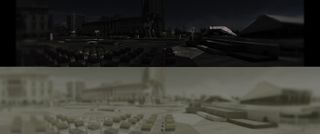Do Digital Cameras Affect Cats' Eyes
Cats and Dogs May See in Ultraviolet

A house cat'due south baroque antics may be more just feline folly. The kitty may be seeing things that human eyes tin't.
Unlike humans, many animals see in ultraviolet, and a written report now suggests that cats, dogs and other mammals can, likewise. Knowing these animals see things invisible to humans could shed some light on the animals' beliefs, the researchers say.
"Nobody ever thought these animals could meet in ultraviolet, but in fact, they do," said report leader Ron Douglas, a biologist at Urban center University London, in England.
Light is fabricated up of a spectrum of colors. Visible lite (that humans can see) spans from scarlet to violet, and beyond the visible lie ultraviolet wavelengths. Many animals are known to have UV-vision, including insects (such as bees), birds, fish, some amphibians and reptiles, and a handful of mammals (such every bit some mice, rats, moles, marsupials and bats). [Images: Come across the Globe Through Cats' Optics]
Seeing in ultraviolet
The lens of the human centre blocks ultraviolet light, but in animals with UV-transparent lenses, ultraviolet light reaches the retina, which converts the light into nerve signals that travel to the brain where the visual system perceives them.
Even in animals whose retinas aren't very sensitive to UV light, some of the light is nevertheless absorbed. (In fact, humans who have had their center lenses removed, such as in cataract surgery, without being replaced by ultraviolet-blocking lenses report beingness able to see in the ultraviolet.)
In this study, the researchers obtained eyes from a smorgasbord of mammals — everything from hedgehogs to ruddy pandas to macaque monkeys — who had died or were killed, donated past zoos, veterinarians, slaughterhouses and scientific discipline labs. The scientists measured how much light got through the lens of each beast'south eye to its retina.
The team constitute that many of the animals, including hedgehogs, dogs, cats, ferrets and okapis (relatives of giraffes that alive in the central African rainforest), have lenses that let some ultraviolet light through, suggesting these animals may see in the ultraviolet.
This begs the question, what purpose does ultraviolet vision serve?
"The question is only being asked because humans tin can't see it," Douglas told Live Science, adding that nobody asks why humans see other colors.
Nevertheless, ultraviolet vision does serve several purposes. Bees and other insects utilise it to see colors or patterns on plants that can straight them to nectar. Rodents use it to follow urine trails. And reindeer may utilise ultraviolet light to see polar bears, which, in visible low-cal, alloy in with the snow.
Why cake UV?
The better question, Douglas said, is why human eyes cake out ultraviolet light. 1 possibility is that ultraviolet low-cal damages the retina, only as it amercement the skin over fourth dimension. But many long-lived animals that are active during the twenty-four hour period, such as reindeer, have ultraviolet vision, and "their eyes don't fall apart," Douglas said. [What If Humans Had Eagle Vision?]
A more likely explanation for why man eyes filter out ultraviolet light is to ameliorate visual acuity. Skiers clothing yellowish goggles that block UV low-cal specifically for this reason. The researchers looked at the animals that blocked the virtually ultraviolet low-cal, and found these were the same animals with the highest-resolution vision.
Humans are expert at seeing detail, because they have a loftier density of color-sensitive cells, or cones, in their retinas, which produce high-quality images with just a small amount of calorie-free. By contrast, nocturnal animals accept eyes that let in as much light as possible, including ultraviolet light, though it may non serve any special purpose.
Ultimately, knowing that many animals have ultraviolet vision could provide a deeper understanding of why they behave the style they exercise. Or mayhap your cat really is only crazy.
Follow Tanya Lewis on Twitter and Google+ . Follow us @livescience , Facebook & Google+ . Original commodity on Live Science.
Source: https://www.livescience.com/43461-cats-and-dogs-see-in-ultraviolet.html
Posted by: batcheldersweir1967.blogspot.com


0 Response to "Do Digital Cameras Affect Cats' Eyes"
Post a Comment